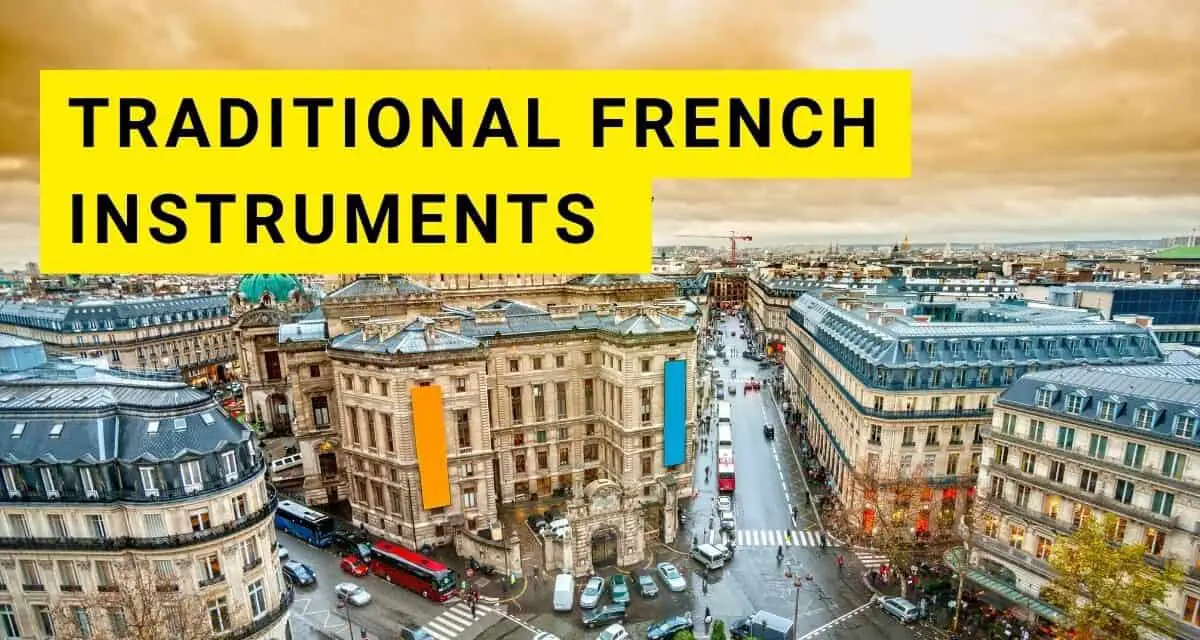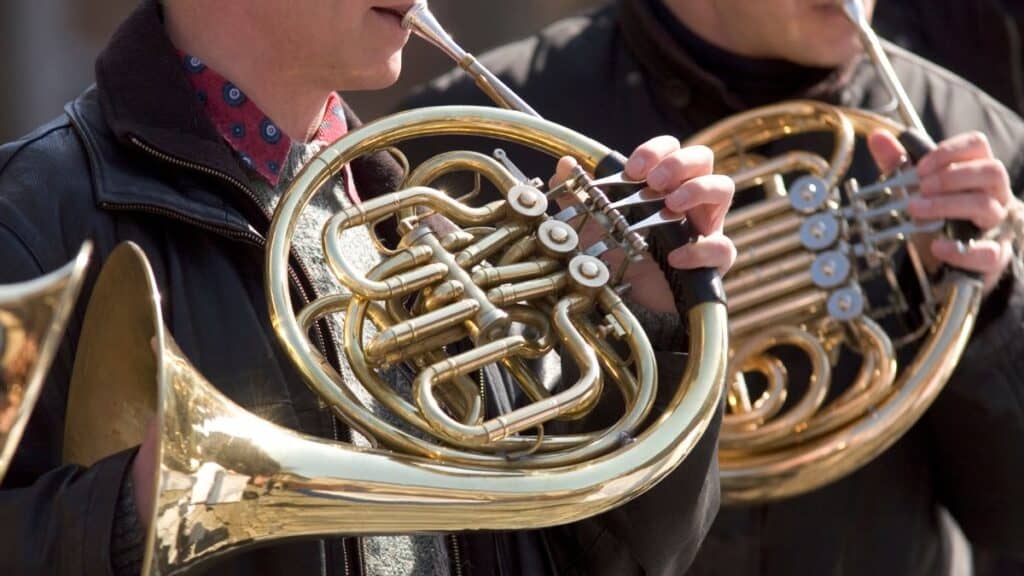Step into the heart of France and you’ll hear the rhythm of a nation with these incredible musical instruments.
From the serene melodies of the harp echoing through the hallowed halls of a cathedral, to the spirited blare of the bombarde in a Breton fest-noz, France’s musical instruments provide a diverse symphony of sounds.
Each instrument, from the smallest fife to the grandest piano, contributes its own unique voice, shaping the music into a rich tapestry of sonic experiences.
We are going to dive into a journey through the musical instruments that form the backbone of traditional French music, breathing life into the nation’s cultural narrative.
French Horn
A star in the world of orchestral music, this musical instrument offers a harmonious blend of smooth tones and powerful dynamics.
Although its origins aren’t exclusively French, this brass instrument has a distinct place in the nation’s classical music.
Its extensive range, from delicate whispers to triumphant roars, makes the French horn a versatile storyteller.
Accordion
The Accordion, or Accordéon, is emblematic of French music, particularly the nostalgic tunes of Parisian streets.
This squeezebox instrument, with its characteristic bellows and keys, produces a range of sounds, from lilting melodies to rhythmic accompaniment. Its resonant tones are deeply intertwined with genres like chanson and musette, echoing the soulful rhythm of France.
It is possibly the most iconic traditional instrument when one thinks of traditional music from France and is best paired with a well-rounded red wine.
Cetera
The Cetera is a plucked string instrument originally from the island of Corsica.
It’s quite similar to a dulcimer, boasting 16 to 18 strings that offer a harmonious, multi-layered sound. This instrument is traditionally used in polyphonic songs of Corsica, providing a melodious backdrop for the rich, layered vocals.
The sound of a Cetera is resonant and full-bodied, exuding a serene, calming aura that perfectly complements the passionate and moving Corsican songs. This traditional plucked string instrument is a window into the musical soul of Corsica, painting sonic landscapes that echo the beauty and culture of the island.
Violin
In the realm of French traditional and classical music, the Violin holds a prominent role. With its rich, versatile tones, it adds depth and emotion to compositions.
Violin performances in French music can range from swift, jaunty folk dances to slow, soul-stirring symphonies, truly epitomizing the musical diversity that France cherishes.
Harp
The French Harp, or Harpe, weaves a tapestry of ethereal sounds that resonate with the elegant spirit of French music.
Found in orchestral music and Celtic-influenced genres of Brittany, the Harp’s mesmerizing notes bring an otherworldly charm.
Whether it’s producing rhythmic pulses or cascading melodies, the Harp adds an unmistakable grace to the French musical landscape.
Hurdy-Gurdy
The Hurdy-Gurdy, or Vielle à Roue, is a peculiar yet fascinating part of French traditional music, particularly in central France.
It’s a string instrument played by turning a crank, and the resulting sound is a unique combination of a violin and a bagpipe – a drone with a melody. The Hurdy-Gurdy’s distinct timbre and folkloric vibe lend a robust, rustic flavor to French music.
Bagpipe
Although Bagpipes might be more commonly associated with Scotland, France boasts its own versions, notably the Cabrette and Biniou.
These pipes provide a resonant, reedy backdrop to the folk music of regions like Brittany and Auvergne. Their characteristic drone, a continuous, harmonious hum, intermingled with the sharp, punctuated notes of the melody, creates a sonic experience that’s both rustic and engaging.
Bombarde
Dominating the traditional music of Brittany, the Bombarde is a high-pitched, oboe-like instrument that produces a bright, penetrating sound. Often played in tandem with the Biniou, its assertive tones command attention, punctuating the musical arrangement with sharp, resonant notes.
The Bombarde’s distinctive sound, reminiscent of the call of a trumpet, adds an audacious flair to French folk music.
Cornemuse
The Cornemuse, a type of French Bagpipe, is known for its deep, rich tones that provide a harmonic foundation to folk ensembles, particularly in central France.
The term “Cornemuse” actually encompasses a variety of bagpipes, each with its regional flavor, contributing to the diverse tapestry of French music with their earthy, robust sounds.
Cialamedda
The Cialamedda is a Corsican reed instrument that has evolved over time to feature a wooden box body. Known for its full, robust sound, the Cialamedda forms the rhythmic backbone of many traditional Corsican songs, breathing life into the island’s rich musical narrative. Its vibrant, earthy tones are resonant of the island’s rustic landscapes and deep cultural heritage. With each note, the Cialamedda weaves an intricate sonic tapestry, painting a vivid musical picture of Corsica’s soulful folk traditions and warm, inviting spirit.
Fife
A small, high-pitched flute, the Fife is an integral part of French folk music, particularly in military and marching bands. It produces a sharp, clear sound that carries over long distances, making it perfect for outdoor performances.
The Fife’s energetic, lively tunes add an infectious spirit to the performances, embodying the vibrant essence of French musical traditions.
Piano
Not to forget the Piano, an instrument of elegance and versatility. Its presence in French music ranges from classical compositions of greats like Chopin and Debussy, to the emotive accompaniment in French chansons and contemporary music.
With its expansive range of notes, the Piano is a storyteller, setting the mood and narrating the melody in the language of music.
Orgue de Barbarie
The Orgue de Barbarie, or the barrel organ, is a staple in French street music, carrying with it an air of nostalgia and romance. This mechanical musical instrument is operated by turning a crank, it plays music encoded onto large wooden cylinders, bringing to life tunes that range from popular songs to classical pieces.
Its robust, melodious sound carries a certain whimsical charm that resonates with the jovial atmosphere of a French street fair or a bustling market square.
Often accompanied by singing from the organ grinder, the mechanical musical instrument fills the air with a timeless, enchanting rhythm that truly captures the spirit of traditional French culture.
Concertina
The Concertina, often found in sailor songs and sea shanties, is a free-reed instrument akin to the accordion. Its compact, hexagonal shape houses a complex arrangement of buttons that, when combined with the bellows, produce sharp, vibrant notes.
The Concertina’s energetic, quick-paced melodies add a distinctive rhythmic flavor to traditional French maritime music.
Cabrette
Originating from the Auvergne region, the Cabrette is a type of French bagpipe. Its unique, vibrant sound, characterized by a continuous drone overlaid with a melodic line, forms the backbone of local folk dances and tunes.
The Cabrette’s high, bright tones infuse an unmistakable lively spirit into the musical ensemble, creating a captivating sonic portrait of rural France.
Musette de Cour
The Musette de Cour, or simply Musette, is a small bagpipe that was extremely popular in French court music of the 18th century.
Its smaller size gives it a higher pitch than other bagpipes, and its sweet, delicate sound adds a refined touch to the French Baroque music, encapsulating the elegance of the era.
Flageolet
The Flageolet is a woodwind instrument similar to a recorder, but with a softer, more mellow sound. Once popular in French court music, it’s now mostly found in traditional folk tunes.
The Flageolet’s soothing, melodic tones add a touch of nostalgia to the French musical tapestry, serving as a gentle reminder of bygone eras.
Tambourin
The Tambourin is a traditional French drum, often seen in the folk music of Provence. It is one of the more prominent percussion instruments found in the region.
Its rhythmic beats provide a steady, pulsating backdrop to the melody, driving the energy and tempo of the performance.
The Tambourin gives body to the music, laying the foundation upon which the melodic instruments weave their narratives – making it unique among percussion instruments.
Orgue de rue
The Orgue de rue, or street organ, is an automatic mechanical pneumatic organ from Paris, Île-de-France, specifically designed for its portability and ability to bring music to the streets.
This fascinating instrument, powered by air and controlled by perforated paper rolls, can produce a wide range of melodies, from classical tunes to popular folk songs.
The Orgue de rue’s lively, resonant sound echoes through the bustling Parisian streets, infusing them with a vibrant, rhythmic energy. It’s a symphony on wheels that captures the dynamic, ever-changing pulse of the city, bringing people together in a shared celebration of music and culture.
Biniou
The Biniou is a type of bagpipe native to Brittany. Known for its high, piercing sound, it’s often played alongside the Bombarde in traditional Breton music.
The Biniou’s intense, vivacious notes bring a raw, rustic energy to the music, encapsulating the rugged beauty and spirited folklore of the Breton region.
Boîte à musique (Music Box)
A Boîte à musique (Music Box) is an automatic musical instrument that holds a special place in French musical tradition.
These delicate devices play tuneful melodies by plucking the teeth of a metal comb with a revolving cylinder, creating a tinkling, magical sound that feels like a sprinkle of fairy dust.
Music boxes often serve as nostalgic keepsakes, playing classic French lullabies or love songs that tug at the heartstrings. Each note from a Boîte à musique feels like a trip down memory lane, weaving stories of love, dreams, and childhood in its enchanting melodies.
French Musical Instruments Create Amazing Musical Sounds
So, there we have it – a musical tour de France, brought to life by the sounds of its traditional instruments. Each of these instruments, with their unique voices, tells a story of the country’s diverse regions and rich cultural history.
From the elegant strains of the Musette de Cour to the rustic vigor of the Biniou, French music is a harmony of contrasts. It’s a symphony that echoes with the spirit of the nation – a spirit of creativity, diversity, and a deep love for the melody of life.
Tune in, and let the music of France transport you to its charming boulevards, rustic countrysides, and the very heart of its cultural identity.







